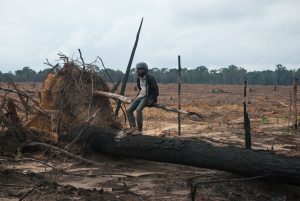In Cambodia, few protected areas are under as much threat from deforestation as the Prey Lang Wildlife Sanctuary. For years, this protected area, which covers some 430,000 hectares across Kratie, Stung Treng, Kampong Thom, and Preah Vihear provinces in north-central Cambodia, has been gradually hollowed out by logging operations linked to well-connected tycoons and government officials.
Last year a report found that Prey Lang had lost more than 100,000 hectares of forest between 2000 and 2019, around 24 percent of its total land area. More than half of this was converted into plantations of cash crops, mostly rubber.
And according to satellite images and remote sensing data, illegal logging operations have only continued to intensify inside Prey Lang, as the ruling Cambodian People’s Party (CPP) government has ramped up its offensive against local activists fighting to keep the loggers at bay.
According to a statement by the rights group Amnesty International, deforestation alerts, created by the University of Maryland in partnership with Global Forest Watch, show widespread forest clearings during 2020 and early 2021. Images taken on February 5 of this year, for instance, show many piles of logs visible in a newly-cleared area just outside Prey Lang. They also show new access roads snaking into the sanctuary, which were not visible in previous imagery from a year earlier.
Amnesty claims that the deforestation of Prey Lang has increased in line with an intensifying clampdown on activist groups like the Prey Lang Community Network (PLCN), which conducts patrols of Prey Lang and on occasions has destroyed logging equipment and caches of cut wood.
A year ago today, according to the rights group, PLCN activists and other environmental defenders were barred from entering Prey Lang, removing one of the few checks on the activities of loggers and concessionaires within the protected zone. Last week, the Ministry of Environment rejected a request by PLCN members to hold their annual tree blessing ceremony in Prey Lang on February 25.
“While Cambodian authorities prevent the Prey Lang Community Network and environmental defenders from protecting the Prey Lang wildlife sanctuary, illegal loggers are clearing land with impunity,” Richard Pearshouse of Amnesty said in the group’s statement.
This followed the arrest in early February of five environmental activists inside Prey Lang. The group included Ouch Leng, a forestry activist who in 2016 was awarded the prestigious Goldman Environmental Prize for his undercover work aimed at documenting and exposing the corrupt networks that sustain illegal logging in Cambodia.
Ouch Leng and his colleagues had been collecting evidence of illegal logging in an area adjacent to a concession operated by the Cambodian subsidiary of South Korea’s Think Biotech Co. Ltd. On February 8, the activists were freed from the provincial Forestry Office where they had been held after being forced to sign a document pledging to cease their activities in Prey Lang without permission from the Ministry of Environment.
According to PLCN, which emerged about a decade ago, since deforestation inside Prey Lang began to accelerate, the sanctuary has faced two main challenges: the clearing of large tracts for the construction of agricultural plantations, or the cherry-picking of individual valuable hardwood trees, which are exported to Vietnam or China for the manufacture of high-end furniture or gaudy lacquered knick-knacks.
Many of the 250,000-odd people who live in and around Prey Lang are Kuy, an indigenous minority group for whom the forests are not just an economic lifeline, but also have spiritual significance. On a visit to Prey Lang with members of PLCN in 2013, I stood in massive clearings that had been scraped clear to make way for rubber plantations. Among the churned earth, stumps still smoldered.
The clampdown on PLCN has taken place against the backdrop of the Cambodian government’s broader crackdown on environmental activists, a fact that can be explained by the fact that logging revenues are central to Cambodia’s extractive political economy, greasing the gears of patronage that sustain the CPP’s control.
While Cambodian legislation contains a raft of punishments for illegal logging, in practice the law is rarely enforced, and state officials, up to and including the inner circle of Prime Minister Hun Sen, have long been reported to be active beneficiaries of the trade. As long as this system is in place, the days of Prey Lang as a meaningfully protected area would seem to be numbered.

































